When planning a wedding, choosing the right flowers is essential to setting the tone and atmosphere of your special day. Lisianthus, with its elegant, rose-like appearance and versatile color palette, has become an increasingly popular choice for brides seeking sophistication and charm. Known for its trumpet-shaped petals that come in hues ranging from peach and lavender to white and pink, this flower offers both beauty and symbolism. But what truly sets Lisianthus apart in wedding floristry, and how can you best incorporate it into your arrangements? The answers might just surprise you.
Flower Overview
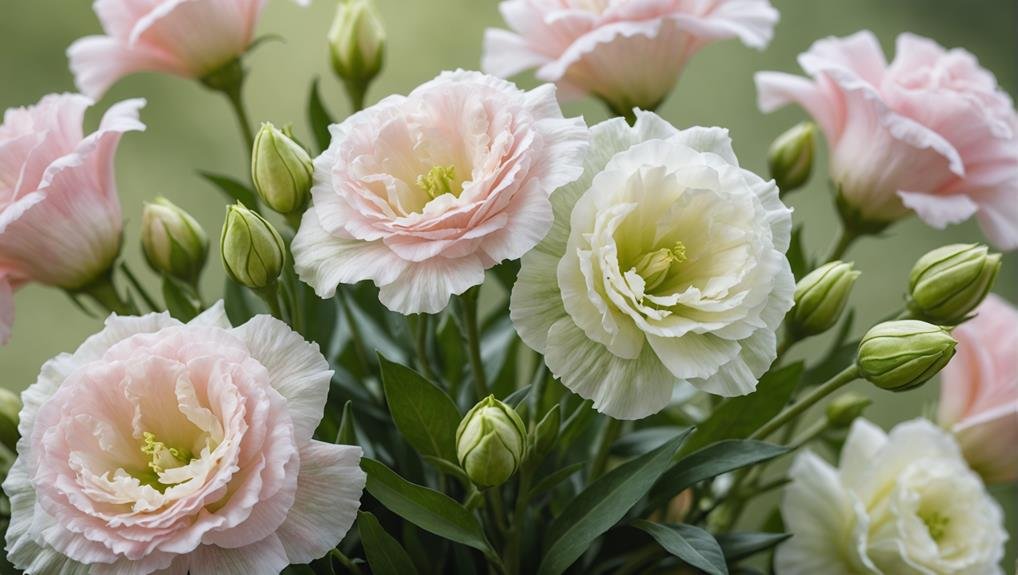
Renowned for their grace and elegance, Lisianthus flowers, also known as Texas Bluebell and Prairie Gentian, captivate with their trumpet-shaped blooms and diverse color palette. These flowers are highly regarded in the domain of wedding floristry, where their beauty and symbolism make them an exceptional choice for various arrangements.
Lisianthus flowers symbolize grace, elegance, gratitude, and charm—qualities that align perfectly with the sentiments of a wedding celebration. Their delicate appearance and range of colors, including peach, lavender, purple, pink, and white, provide versatile options for creating stunning bouquets, centerpieces, and boutonnieres.
Lisianthus is particularly favored for wedding bouquets due to its long stems and glossy green leaves, which add a touch of sophistication and natural beauty. The blooms can be incorporated into both modern and traditional wedding themes, seamlessly blending with other flowers or standing out on their own.
Their year-round availability guarantees that brides can enjoy these exquisite flowers regardless of the season. Whether used as a focal point or an accent, Lisianthus flowers bring a timeless elegance to wedding floral arrangements, enhancing the overall aesthetic and ambiance of the special day.
Physical Description
Lisianthus flowers feature trumpet-shaped blooms with five petals fused together, creating a delicate and intricate floral structure. The flowers’ resemblance to a cross between a rose and a tulip provides them with a unique, beautiful appearance that is both elegant and graceful. The long stems of Lisianthus are adorned with glossy green leaves, contributing to their overall aesthetic appeal and making them suitable for various floral arrangements.
The versatility of Lisianthus is further enhanced by their diverse and versatile colors, which include shades such as peach, lavender, purple, pink, and white. These hues complement a wide array of wedding themes and color palettes, making Lisianthus a popular choice for creating stunning bouquets, centerpieces, boutonnieres, and corsages. The blooms are celebrated for their year-round availability, ensuring that they can be incorporated into weddings regardless of the season.
Known also as Texas Bluebell and Prairie Gentian, Lisianthus symbolizes grace, gratitude, and appreciation, adding a layer of meaning and sentiment to their physical beauty. Their trumpet-shaped structure and long stems lend themselves well to both contemporary and traditional floral designs, making them a versatile and cherished option for wedding florists.
Available Colour Varieties
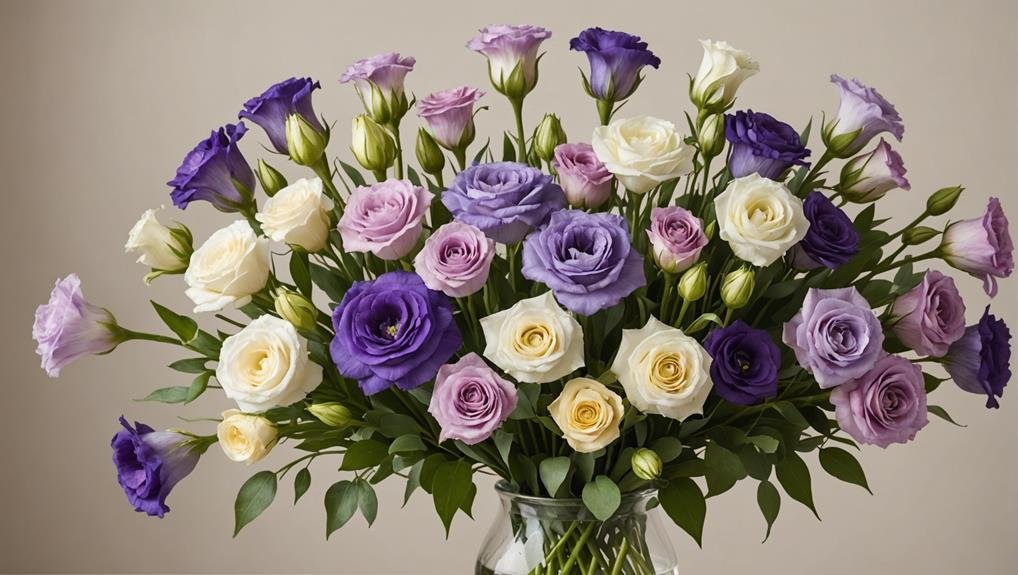
The extensive color range of Lisianthus flowers enhances their versatility and suitability for any wedding theme. This beautiful bloom is available in an impressive variety of Lisianthus colors, including white, red, blue, yellow, pink, purple, and orange. Additionally, some varieties come in multicolored options, adding a unique and modern touch to bouquets.
| Color | Description |
|---|---|
| White | Pure and elegant, ideal for classic wedding themes. |
| Pink | Soft and delicate, perfect for a romantic look. |
| Multicolored | Unique and modern, great for bold and contemporary designs. |
The wide array of colors allows for elegant and customizable arrangements that can seamlessly match bridesmaid dresses and overall wedding aesthetics. Whether opting for a monochromatic scheme or a mixed color bouquet, lisianthus flowers contribute sophistication and charm to wedding floral arrangements.
The pink lisianthus, in particular, offers a soft and romantic look, making it a favorite among brides. The diverse color palette of lisianthus guarantees that it is a versatile choice for creating romantic, vibrant, or subtle bouquets to suit various wedding styles. From understated elegance to vibrant celebrations, the variety of Lisianthus colors makes them an excellent choice for any wedding.
Latin Name and Taxonomy
Known scientifically as Eustoma grandiflorum, Lisianthus belongs to the Gentianaceae family, showcasing its rich botanical heritage. The genus name ‘Eustoma’ derives from the Greek words ‘eu’ and ‘stoma,’ meaning ‘beautiful mouth.’ This name aptly reflects the flower’s exquisite and alluring appearance, making it a popular choice for weddings and other special occasions.
As a member of the Gentianaceae family, Lisianthus shares its lineage with a variety of other flowering plants known for their beauty and complexity. The plant is dicotyledonous, which means it has two embryonic leaves or cotyledons, a characteristic feature of many flowering plants within this family. With its long, slender stems and striking trumpet-shaped flowers, Eustoma grandiflorum stands out in floral arrangements and bouquets.
Commonly referred to as Texas Bluebell or Prairie Gentian, Lisianthus is renowned for its versatility and elegance. Its various common names often reflect its regional presence and distinctive floral attributes. The term Texas Bluebell highlights its native presence in the southern United States, further emphasizing its connection to local flora.
This botanical marvel continues to enchant flower enthusiasts and wedding planners alike with its graceful beauty.
Geographical Origins
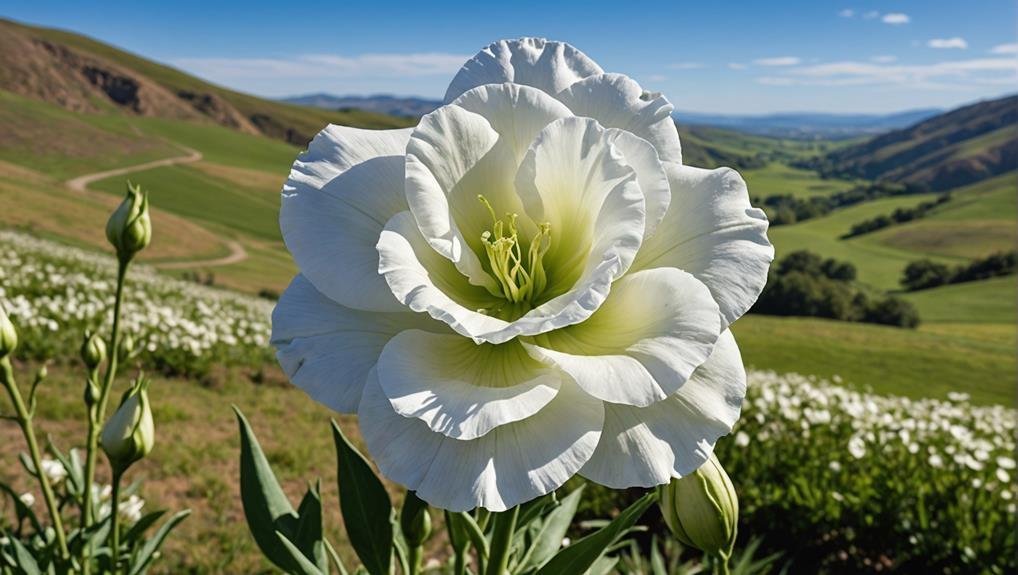
Originating from the warm regions of North and South America, particularly Texas and Mexico, Eustoma grandiflorum showcases its resilience and adaptability in various climates. Commonly known as Lisianthus flowers, these blooms thrive in well-drained soil and sunny locations, making them suitable for an array of geographical settings. Their natural habitat in the warm climates of Texas and Mexico has contributed significantly to their ability to flourish in diverse environments.
The global distribution of Lisianthus flowers has expanded considerably due to their popularity and versatility. They are now cultivated in greenhouses and fields across the United States, Japan, and the Netherlands. This international cultivation ensures that Lisianthus is available for various uses, including wedding floral arrangements, throughout the year.
| Region | Climate Characteristics | Cultivation Practices |
|---|---|---|
| Texas and Mexico | Warm, sunny, well-drained | Natural habitat |
| United States | Varied, greenhouse | Controlled environments |
| Japan and Netherlands | Mild, temperate | Greenhouse and field-grown |
The adaptability of Lisianthus flowers to different climates and growing conditions underscores their global appeal. With numerous varieties tailored to specific regions, Lisianthus continues to be a favored choice for floral designers worldwide. Their geographical origins not only highlight their natural resilience but also their widespread adaptability and appeal.
Season Availability
Lisianthus flowers boast year-round availability, making them a great option to include in wedding decor regardless of the season. This characteristic makes them an incredibly versatile choice for wedding flowers, as couples do not need to worry about seasonal limitations when planning their floral arrangements.
Whether your wedding is set in the fresh bloom of spring, the warmth of summer, the vibrant colors of fall, or the crisp air of winter, lisianthus flowers remain a consistent and reliable option. Their consistent availability allows for a wide range of design possibilities and color choices, accommodating various wedding themes and color schemes.
This flexibility is particularly advantageous for couples who wish to maintain a specific aesthetic or color palette, knowing they can rely on lisianthus to be in season. Moreover, the year-round availability of lisianthus ensures that florists can source these flowers without difficulty, leading to more predictable and stable pricing.
Incorporating lisianthus into your wedding floral arrangements means you can confidently plan without concerns about seasonal restrictions. This reliability not only simplifies the planning process but also provides peace of mind, knowing that these elegant flowers will be available to enhance your special day.
Growing Conditions
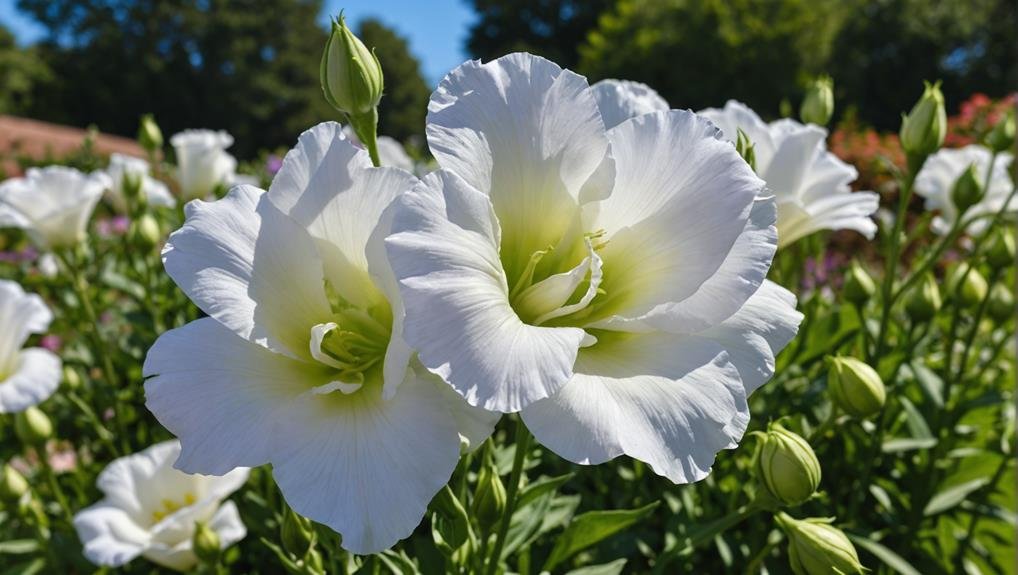
Thriving in full sun to partial shade, lisianthus flowers need well-draining soil with good fertility to flourish. These delicate blooms are recognized for their beauty and versatility, making them a popular choice for wedding arrangements. Understanding the growing conditions for lisianthus is essential to guarantee their successful cultivation.
Lisianthus flowers benefit from exposure to full sun, though they can tolerate partial shade, especially in hotter climates. The key to healthy growth lies in the soil: it must be well-draining to prevent waterlogging, which can lead to root rot. Fertile soil, rich in organic matter, provides the necessary nutrients for robust plant development.
Watering practices are equally significant. Lisianthus plants are sensitive to overwatering and therefore require moderate watering. Ensuring the soil remains moist but not soggy is vital.
The ideal temperature range for growing lisianthus is between 60-80°F, providing a temperate environment that supports their growth cycle.
Whether grown in containers or garden beds, maintaining these ideal growing conditions will result in vibrant and healthy lisianthus flowers. Adhering to these guidelines guarantees that these elegant blooms will be a stunning addition to any wedding arrangement.
Cultural Significance
Renowned for its grace and elegance, the lisianthus flower holds deep cultural significance in ceremonies and celebrations across various societies. In numerous cultures, lisianthus is treasured for its symbolism of beauty, purity, and heartfelt emotions. Known by names such as Texas Bluebell and Prairie Gentian, this flower has a storied history in traditional ceremonies and events, where its delicate blooms convey messages of love, appreciation, and celebration.
The cultural significance of lisianthus is deeply rooted in its representation of grace and elegance. Historically, it has been employed in rituals and festivities to symbolize gratitude, charm, and appreciation. This symbolism is particularly evident in its use during festive occasions, where lisianthus flowers are chosen to adorn spaces and highlight the beauty of special moments.
In various cultural traditions, the presence of lisianthus during ceremonies is a gesture that signifies blessings and best wishes. Whether celebrating milestones or participating in traditional ceremonies, the inclusion of lisianthus flowers reflects a deep appreciation for the aesthetic and emotional qualities they bring. Through its enduring symbolism, the lisianthus continues to play an essential role in expressing profound sentiments in diverse cultural contexts.
Typical Use in Weddings
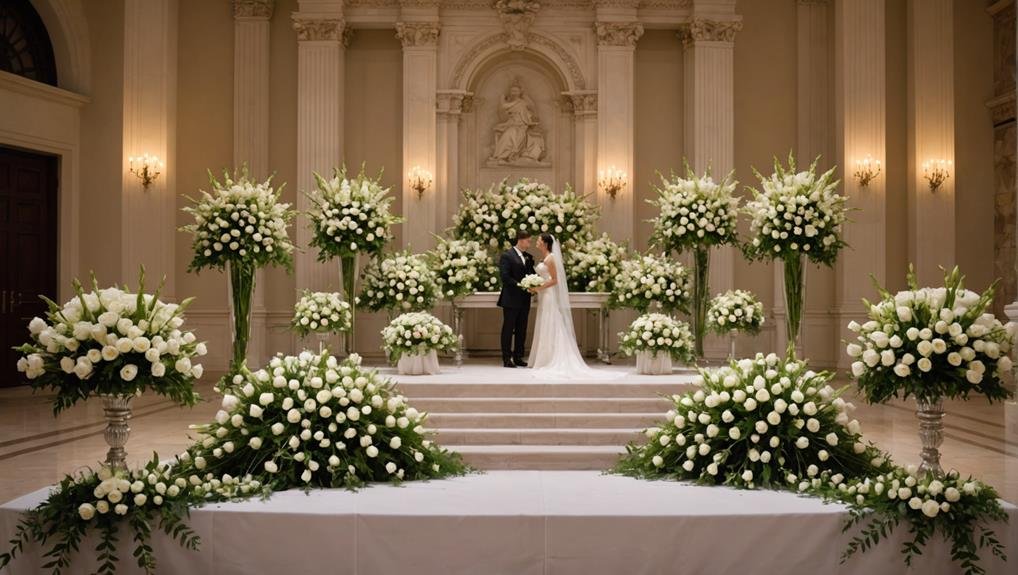
In wedding arrangements, the versatile lisianthus flower is frequently chosen for its ability to add height, elegance, and visual interest to bouquets, centerpieces, and ceremonial decor. Its multi-petaled blooms make it an excellent choice for creating lush bridal bouquets that exude sophistication.
The flower’s graceful structure also makes it ideal for centerpieces, where it can stand alone or be paired with other florals to craft stunning table arrangements for the reception.
Lisianthus is equally effective in DIY wedding or event setups due to its longevity and cost-effectiveness. Its durability guarantees that arrangements remain fresh throughout the festivities, making it a favorite among budget-conscious couples who seek beauty without compromise.
Aisle decorations featuring lisianthus can elevate the ceremonial space, adding a touch of elegance as the bride walks down the aisle.
Additionally, lisianthus flowers are versatile enough for crafting flower crowns, toss bouquets, and even hair flowers, adding a cohesive floral theme. Whether incorporated into extravagant ceremony urns or delicate boutonnieres, lisianthus effortlessly complements various wedding styles, from rustic to modern. Its broad appeal and adaptability establish it as a staple in wedding floral design.
Alternative Flower Types
When considering alternative flower types for wedding arrangements, lisianthus stands out as a versatile and cost-effective option. Known for its unique bell-shaped bloom and a wide range of colors, lisianthus can rival traditional choices like roses, peonies, and hydrangeas. Its long-lasting vase life guarantees that bouquets and centerpieces remain fresh throughout the event, making it the perfect wedding flower for both its aesthetic appeal and practicality.
Lisianthus is not only lovely but also adaptable to various wedding decor styles, whether rustic or elegant. This flower can seamlessly blend into different themes, providing beauty and sophistication without the premium price tag. Below is a comparison table highlighting the distinct features of lisianthus as an alternative flower type for weddings:
| Flower Type | Key Features | Cost-Effectiveness |
|---|---|---|
| Lisianthus | Bell-shaped blooms, extended vase life | High |
| Roses | Classic beauty, variety of colors | Moderate to high |
| Peonies | Lush, full blooms, seasonal availability | High |
| Hydrangeas | Large, voluminous clusters | Moderate to high |
| Carnations | Fragrance, wide color range | High |
